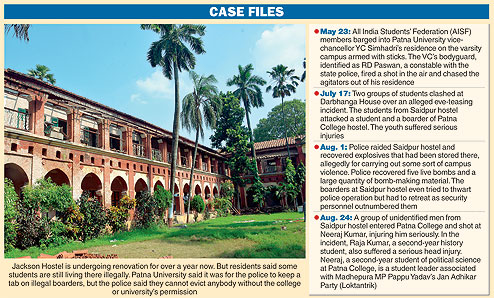The saucer-shaped topography of the city, age-old drainage network, incomplete rainwater discharge projects have once again brought back the horror of heavy waterlogging on the streets.
Patna received 111.4mm rainfall over the past four days. Despite tall claims of monsoon-preparedness by the Patna Municipal Corporation (PMC) and a slew of directives for the same issued earlier by Patna divisional commissioner Anand Kishor, Lohanipur, Kadamkuan, Sabjibagh, Station Road and Exhibition Road and other areas witnessed knee-deep water following rain over the past few days.
The city streets continued to be under water even as Patna aspires to become a smart city. The Telegraph probes the reasons behind the waterlogging menace
Age-old drainage
The drainage network in the city is based on small and big drains developed in 1968 (around 50 years ago). As a result, they do not have the required capacity to hold and drain out the excess rainwater. As per the Patna City Development Plan prepared in 2006 under the centrally sponsored Jawaharlal Nehru Urban Renewal Mission (JNNURM), the existing drainage network is limited to certain areas and even those are choked by heavy siltation and dumping of garbage.
"As per the findings of the infrastructure survey conducted recently under the seven resolves of the state government, 13 per cent of the roads in Patna are devoid of drains. The drainage network in Patna is sewage-cum-drainage network meant for discharge of waste water generated regularly in the city and not one meant for discharge of excess rainwater," said R.S. Choudhary, retired chief town planner at the urban development and housing department.
Sewerage in limbo
As Patna does not have a separate storm water drainage network and the existing sewerage-cum-drainage network is also insufficient, an ambitious project for augmenting the network was conceptualised in 2013.
The project aims at developing the maiden pipeline-based sewerage network.
The length of the pipeline under the new sewerage project is proposed to be around 1,300km and it would provide door-to-door connectivity for collection and disposal of waste water. However, the progress in the World Bank-funded project entailing an outlay of Rs 2,500 crore has been quite sluggish.
"Though a bidding process for selecting firm(s) for execution on the project is on, we have not received any funds from the Centre for the project as on date," said a senior official in Bihar Urban Infrastructure Development Corporation (BUIDCo), the executing agency for the project.
Is PMC ready?
The civic body does not have any estimates with regard to capacity of rainwater drainage nor is there any separate storm water drainage network in the city.
However, technical experts in PMC claimed that it can drain out water from the streets in 24 hoursif it rains up to 65mm between 10pm and 2am. However, it would take around 48 hours to drain out the same amount of water if it rains between 2am and 10am. Moreover, it takes more than 48 hours if it rains above 65mm in a day.
"If PMC takes more than 48 hours to discharge water from the city if it rains more than 65mm in a day, it is not difficult to understand why the excess rainwateron Tuesday - 85.9mm was flowing on the city streets evenon Thursday," said Ashok Ghosh, an expert in water management and a retired faculty of AN College.
Saucer-shaped city
As per the Patna City Development Plan prepared in 2006 under JNNURM, the topography of the city is saucer shaped posing difficulty in flushing out water.
"Accumulation of rainwater in case of downpour is inevitable as it is a saucer-shaped city. The development of the city over the past two decades has been done in an unregulated manner," said M.K. Pandey, an urban development expert in Patna.












